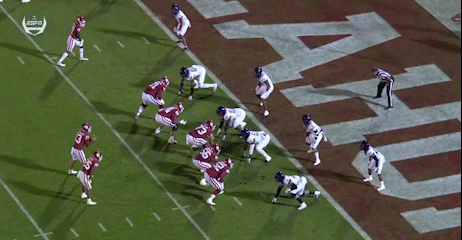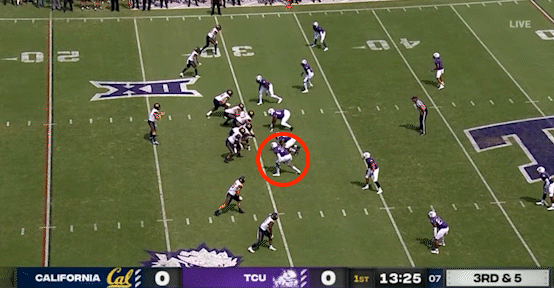MEET A TRANSFER: Ochaun Mathis
The ex-TCU Horned Frog represents the Huskers' best chance for an organic pass rush in nearly a decade
Nebraska made liberal use of the transfer portal this offseason, adding 13 total new players from four-year schools, seven of whom are likely starters. This is the first in a series of posts breaking down of some of the most prominent new names you’ll see on Saturdays, examining their strengths and areas of improvement and what sort of impact Husker fans can expect.
A player who can win a one-on-one pass rush rep is among the most valuable commodities in any level of football. Go look at a list of the highest-paid defensive personnel or top 10 draft picks in any year of the modern NFL, and it’s sure to be littered with players or prospects whom teams believe can beat an offensive lineman in isolation without scheme help. A good pass rusher is valuable because they change the math for a defensive coordinator in allocating its resources.
Here’s the thought process for a defensive coordinator who doesn’t have an organic pass rush:
A competent quarterback generally is able to find the open receiver every time if they aren’t pressured —> Stopping competent quarterbacks requires generating pressure —> Generating pressure requires me to pull players out of coverage to rush the quarterback —> Pulling players out of coverage creates one-on-one matchups and huge holes/liabilities in the secondary that are a risk to be exploited for monster gains.
Now here’s the thought process of a defensive coordinator who can get home with four:
A competent quarterback generally is able to find the open receiver every time if they aren’t pressured —> Stopping competent quarterbacks requires generating pressure —> OK lol I’m just gonna have one of my DAWGS go sack them and leave seven in coverage.
In Erik Chinander’s four years at Nebraska, he has very firmly been in the first camp. The Huskers have not been able to develop a player capable of winning against Big Ten offensive tackles since at least Randy Gregory, who was at NU so long ago that he’s been able to have MULTIPLE redemption arcs in the NFL. Meanwhile, NU was rolling out edge rushers who looked like this:
Finding edge players who can win individual matchups against offensive linemen will be especially important as the Huskers transition to the quasi-4-2-5 split-safety defense they increasingly used last year as their base look. Replacing a 3-4 linebacker with a nickel safety in a 4-2-5 (and not compensating by bringing a safety down in a Cover 1 or Cover 3 shell) inevitably leaves you a gap short in the run game, and playing as much Cover 4 as NU does limits your options on who you can bring on blitzes against the pass. There are a lot of advantages to playing this new defense (getting a linebacker off the field to match up better with modern offenses, increased speed and creativity, limiting big plays), but if you can’t find (a) interior defensive linemen who can play play a gap and a half, and (b) edge rushers who can win one-on-one matchups, you risk leaving yourself open to being papercut to death by runs and not being able to generate any pressure on quick passes. Think about the times the (healthy) Blackshirts struggled last year: It was typically against the teams that were able to pull off the “run for 3 yards, run for 2 yards, pass for 7 yards, run for 4 yards …” script. A talent infusion along the lines helps seal up those gaps and is necessary to be able to play this style of defense.
Enter Ochaun Mathis (pronounced “OH-SHAWN”). Mathis, one of the biggest fishes in this year’s transfer portal pond, comes to Nebraska from TCU, where he was among the Horned Frogs’ best defensive players and a former second-team All-Big 12 selection in 2020. Mathis announced he was leaving Fort Worth on Jan. 12 following the firing of Gary Patterson. Many expected Mathis to follow his former coach to the Texas Longhorns (obligatory HORNS DOWN), but the allure of competition against more NFL-level talent in the Big Ten — and an alleged VERY sizeable NIL deal from Nebraska’s collective — brought him instead to Lincoln.
To get a sense of Mathis’ game I watched TCU’s games against Cal, Texas and Oklahoma.
PROFILE
Position: Outside linebacker/edge rusher
Measurables: 6’5, 260 pounds
Eligibility remaining: One year (plus additional potential COVID-19 year)
Transfer ranking: 0.94 (No. 12 nationally, No. 1 edge rusher)
High school ranking: 0.86 (three star, No. 746 nationally, No. 44 defensive end)
Relevant stats: 15.5 career sacks, 31.0 career tackles for loss
Experience/accolades: 2020 Second-Team All-Big 12 (Media and Coaches), 2021 Preseason All-Big 12 First Team
After a redshirt year as a mid-three star in-state recruit, Mathis was a three-year starter for TCU, breaking out his sophomore season with nine sacks and 14 tackles for loss. He regressed last year to four sacks as TCU’s defense generally went off a cliff (especially against the run, meaning teams didn’t need to pass much and giving Mathis fewer chances to rush the passer). It wasn’t all just frequency, though, as his pass rush win rate dipped from 15.6% in 2020 to 13.1% last year.
Mathis played as a defensive end on a four-man front with the Horned Frogs, lining up as an edge defender in an even front on 74.31% of his snaps in the games I watched. At Nebraska, he’ll switch to the hybrid 3-4 outside linebacker/4-2-5 defensive end role that players like Garrett Nelson and Caleb Tannor have manned the past few years. That role will be essentially identical to what he did at TCU when Nebraska is in its 4-2-5 look, but it might mean some new off-ball or coverage responsibilities and different alignments when Nebraska is in the 3-4 package it employs against more heavy pro-set teams like Wisconsin and Iowa. He played with his hand up on 61.5% of his plays in the games I watched, so that won’t be totally new to him.
STRENGHTS
Speed Rush/Arm Length
The best part of Mathis’ game is his ability to use his speed and stride length to turn the corner on offensive tackles. He doesn’t have an elite first step (it’s fine) off the ball because of his long legs, but when he is able to get going, he REALLY gets going. Offensive tackles struggle to get depth with kick steps against his long strides, and there were plenty of times he just outran them around the edge. He also showed an ability to hook tackles with his arms or dip his center of gravity around them to get a line at the quarterback.
The Horned Frogs took advantage of Mathis’ speed by frequently lining him up in wide gap alignments like 7s (on the inside shoulder of where a tight end would line up) or in Wide 9s (on the outside shoulder of where a tight end would line up or wider) to give him a running start on tackles. Nebraska’s outside linebackers were typically in 5s (on the outside shoulder of the tackle), which Mathis has done plenty of, too:
Lining Mathis up wide sometimes got him washed out on run plays but was effective at getting him some momentum before he had to engage a tackle. That’s something to watch to see if Chinander also utilizes. On probable passing downs, Mathis was moved around inside in some pressure packages and actually lined up inside more often than he did on standard downs, spending 19.04% of his snaps in a 4i alignment (inside shoulder of the tackle) or a 3 (outside shoulder of guard.
It’s not all just pure speed. Mathis also has some Gumby arms that he loves sticking in tackles’ chests as he enters their path to prevent them from getting hands on him. From there he has a nice suite of long arm moves; he seems to favor a swipe move where he throws the tackle past him as he runs by and a hesitation move (he’s generally got a great understanding of varying speeds and tempos to trick tackles)

Smarts/Diagnosing
Something I was impressed with was Mathis’ patience and ability to diagnose plays. Some elite pass rushers are just maniacs off the edge who ignore their other responsibilities to rush the passer on every play and find themselves out of position or baited into screens and draws. Mathis was well coached and disciplined (you don’t get on the field for Gary Patterson without being quizzed to death) and Mathis’ concern about run-game positioning probably cost him a few pass-rush reps in the games I saw.
One example is evident on boot plays when teams ran naked actions toward him. Offenses will often leave the end man on the line of scrimmage they’re booting toward unblocked, hoping he gets sucked in by the run. Mathis pretty consistently did a great job of being patient, diagnosing what the offense was trying to do and keeping contain against the boot:
Overall, his tape showed a patient, heady player who was good at diagnosing offensive concepts and his responsibilities. Playing for one of the best defensive coaches of the last 25 years probably helped with that?
Overall Athleticism/Hustle
Mathis has a few loafs on tape where he isn’t really trying when the play was away from him. But if he has a chance to get in on a play he was a demon in chasing it down. I saw him making several tackles downfield and on run plays away from him.
AREAS OF IMPROVEMENT:
Strength against the run
Mathis’ struggles against the run are probably a huge reason a pass rusher and athlete like him isn’t already in the NFL — and why he might have wanted to prove himself in a conference with physical run games like the Big Ten. He fell off significantly against the run last year, going from a respectable 68.3 PFF run defense grade in 2020 to a !pretty bad! 59.5 in 2021.
The biggest issue seemed to come in just pure strength and ability to set his base. You don’t need your defensive ends in a 4-2-5 to be unmovable granite blocks, but they do need to help the front in stealing back extra gaps, either by (a) getting penetration and affecting the run on the way to rush the quarterback or (b) not getting totally blown off the ball and slowing double teams to allow the linebackers alleys to make plays. There’s a lot of tape on Mathis where he can’t do either because he gets straight-up outmuscled:
It’s especially key for him to be at least a competent run defender in a conference that runs as much outside zone as the Big Ten does. Outside zone is keyed by the ability to wash out the last defensive player on the line of scrimmage; if your edge defender against outside zone is constantly getting housed, consistent lanes are going to be opened. I am having some minor nightmares about Iowa running that play 30 straight times toward him for 6 yards.
Some of it seems like a pure strength issue — there’s lots of tape of him just getting shoved backwards — but Mathis is 260 and pretty rocked up! He is not a light or weak person. I gotta think some of his struggles against the run are improvable with some refined technique. One thing to watch for once the games start to see if he’s improved is to focus on how he moves in relation to the offensive line: If he’s moving parallel and holding blockers up with his arms extended, that’s a win. If he’s moving backwards or being toppled over, that’s bad. Chinander might also attempt to line him up wider against outside zone plays, even out to a 9; that makes it a harder block for the tackle to reach and has been a common answer of NFL teams to the outside zone-style offensive surge in recent years.
Technicality/Countermoves
The speed rush and the moves off it are great, but if it gets stymied, Mathis didn’t really show a developed set of counter moves in the games I saw. Texas’ athletic tackles were mostly able to kick slide with him in that game and he was rendered more or less ineffective when they did. Against Cal, their tackles FLEW out of their stances to get depth to meet his speed rush at the top of the quarterback’s drop. Watch the Cal tackle here false start (wasn’t called) because he’s so anxious to get depth:
When somebody drops that deep that fast, they leave themselves vulnerable to inside moves; you’d love to see Mathis have an inside spin or something to take advantage of that. I didn’t really see any on film.
Tackling
Mathis is going to frustrate a lot of fans with his tackling. He often wasn’t able to get a guy down at point of contact, often getting out over his skis or leaving his feet instead of following through. Watch him whiff in several of the .gifs above.
He did face difficult-to-tackle backs in Texas’ Bijan Robinson and OU’s Kennedy Brooks in two of the games I watched, but there seemed to be some technique and teaching points he could improve on. It also seemed like a bit of a strength issue? Nebraska’s rugby-style tackling that prioritizes side glances with wrapping up instead of direct kill shots with the head may also benefit him here with his long limbs.
EXPECTATIONS:
It’s pretty likely Mathis will start next to Nelson at edge (with Tannor and freshmen Jimari Butler and Blaise Gunnerson also in the rotation). I think there are concerns that people aren’t really contending with — he was not very good last year, an adjustment period is possible, he’s in a tougher, more physical conference and playing for a new staff with a slightly different scheme — but he is also an uber-talented player with a history of elite production so I could also see an eight or nine sack season also being on the table. His struggles against the run probably keep him from being that “superstar”-level player, but at worst he should provide a solid pass rush and make the Blackshirts a lot scarier on third down than they were last season.
NEXT UP: Trey Palmer, wide receiver













